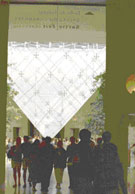|
||||||||||||||||||||||||||||||||||||||

:: I.M. Pei's Pyramide du Louvre . . . << Page 1 <<
Page 2 << Page 3 >> Page 4 >> The Pyramide is a product of uniformity that is completely detached from its historical surroundings. Functioning as an automonument, it does not incorporate any of the physical or aesthetic traits of Le Grand Louvre - it is entirely disconnected, dropped like a foreign object into the center of the courtyard. It, in fact, exemplifies the following statement made by the contemporary postmodern philosopher Jean Baudrillard, who said, "this gives the whole thing a science-fiction feel, as if an attempt had been made to gather all the marks of earthly endeavor and culture together here for the benefit of a visitor from outer space." Discussing the role of the museum in culture and in public life, Baudrillard sees the contemporary museum as a means of fossilizing human nature; a bizarre way of encapsulating human experience and human existence in narcissism. The quote is applicable not only to Le Grand Louvre itself, but to this shimmering, foreign icon poised at the center of gravity in the cour Napoleon. Even Koolhaas says, "museums are sanctimonious Junkspace; no sturdier aura than holiness. To accommodate the convert they have attracted by default, museums massively turn 'bad' space into 'good' space." The Pyramide, centered in the cour Napoleon, gives a false impression of stability, of organization. It's shiny and clear walls, too, give it a mystical feel (or science-fiction feel as Baudrillard would put it), reminiscent of the stained-glass windows built into cathedral walls and ceilings. But the Pyramide is non-exclusive to any particular taste - it is clear, uniform, and monotonous. That this revolutionary object was built in the midst of the urban, Parisian landscape, it serves to identify with the 'good' French principles toward democracy, freedom, justice, and individual free will. (It wouldn't want to hint at the 'bad', for fear of not including the masses or of excluding a taste culture.) Yet, its overriding high-tech characteristics misunderstand the French way of life; the Pyramide breaks away from the French notions of living a simple life. It lacks cultural relevance, cultural identity, and therefore wanes in form as a cultural symbol. Its symbol is bland, generic, empty - as is the falsity of an automonument. The French are by no means a high-tech, electronic society - new technologies are distrusted and they remain a relatively wireless culture, for fear of being tied down or manipulated. Counter this with the United States, a super-dooper electronic society that is wired in every respect - everything is plugged in or dialed up or wired into (i.e., cable). Furthermore, the Pyramide is not representative of the French definition of beauty. Beauty in France is pure, simple, and proud. Take, for an example, La Tour Eiffel, a great steel frame reaching tall into sky. Surely, it, too, is electronically lit at night. But here the lights only serve to outline the great structure, not to reflect radiant walls as with the Pyramide. La Tour Eiffel has no walls. It is open, free, inviting, and honest. With La Tour Eiffel, what you see is what you get. This is not so with the Pyramide. It is closed in, exclusionary, and peculiar. It invites visitors inside, then transports them somewhere else beyond (or below in this case!) the structure itself. Deep inside Le Grand Louvre, the (thoughtless) pyramids are all but forgotten. Their light only glorifies the entryway, and of course the shopping area, which is the misplaced result of entering the Pyramide. Koolhaas once said, "it's a very depressing phenomenon that we can deal with decaying conditions in the city only by inventing weak attempts to restore them or to declare them historical. It would be much more powerful and creative to use other tactics." Here, Koolhaas is lamenting the thoughtless restoration of old or "historical" monuments in urban life. While the Pyramide as an addition and means of restoring the gateway into Le Grand Louvre isn't exactly what one would call thoughtless, its screened-in walls and replicated cohorts render it a symbol of technology, seemingly detached from the French, or from Frenchness. It is futuristic and uninvolved with contemporary life; it is conditioned commercial space that "does not pretend to create perfection, only interest." It is, really, junkspace, a geometric edifice that, to put it simply, just takes up space. With the Pyramide, Pei placed great emphasis on a small design, on preventing the Pyramide from surpassing the height or stature of Le Grand Louvre, but as Koolhaas says, minimum is the ultimate ornament…it does not signify beauty, but guilt…the stricter the lines, the more irresistible the seductions. Its role is not to approximate the sublime, but to minimize the same of consumption, drain embarrassment, to lower the higher… The Pyramide is a pyramid geometrically, but it does
not carry the same connotation as the word pyramid suggests.
Its full name La Pyramide du Louvre, giving ownership over to the Le
Grand Louvre. This, alongside its inferior, subordinate taille
render it ornamental - a distraction from seeing the bigger picture.
|
||||||||||||||||||||||||||||||||||||||
|
:: I. M. Pei's La Pyramide du Louvre: A Diamond in
the Rough or Merely Junkspace? By Rebecca L. Moyer :: The Culture of the Fence: Artifacts and Meanings By Christina Kotchemidova :: On the Significance of Death in Culture & Communication Research By Charlton McIlwain, Ph.D. | ||||||||||||||||||||||||||||||||||||||
|
:: Swept Away By An Unusual Destiny In The Blue Sea Of August: Lina Wertmüller, 1974 - Guy Ritchie's Swept Away 2001 By Laura Meucci :: What Do I Get? Punk Rock, Authenticity, and Cultural Capital By Brian Cogan The Osbournes': Genre, Reality TV, and the Domestication of Rock 'n Roll By Rick Pieto and Kelly Otter |
||||||||||||||||||||||||||||||||||||||
| ::
About Contributors |
||||||||||||||||||||||||||||||||||||||
|
||||||||||||||||||||||||||||||||||||||
| About :: Archive :: Staff :: Submit :: Contact | ||||||||||||||||||||||||||||||||||||||









